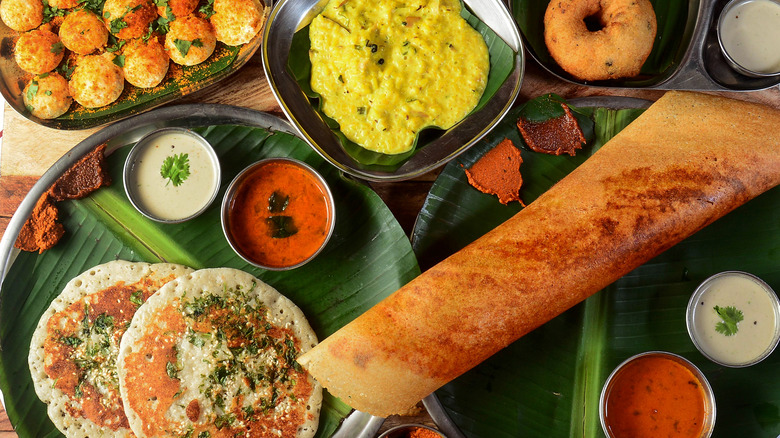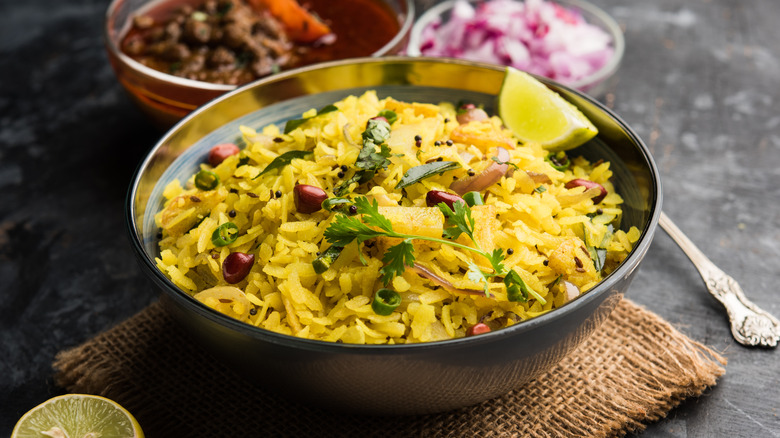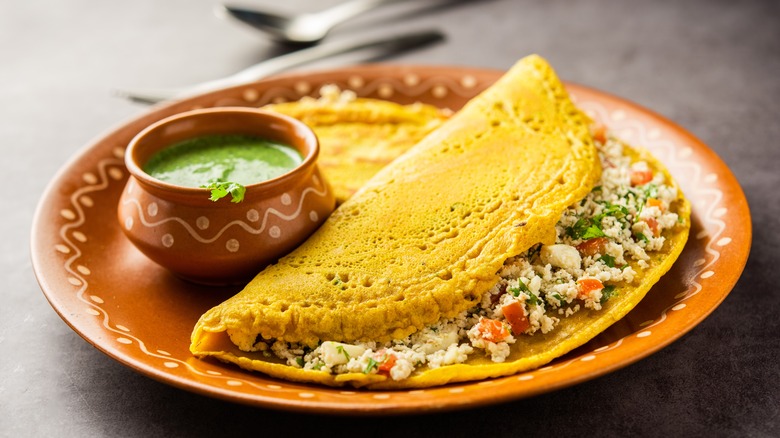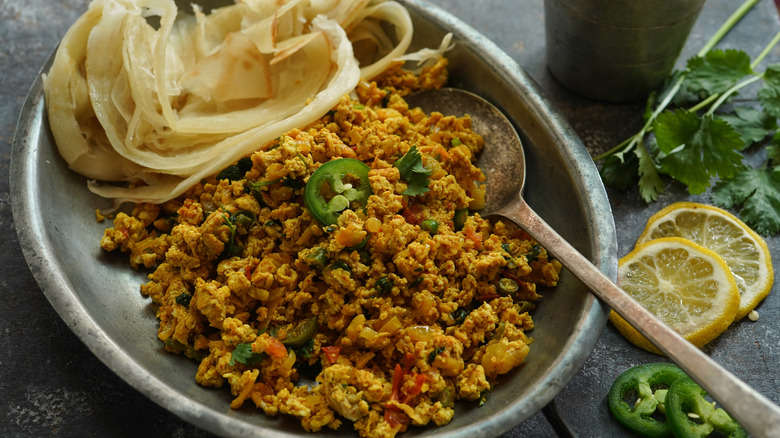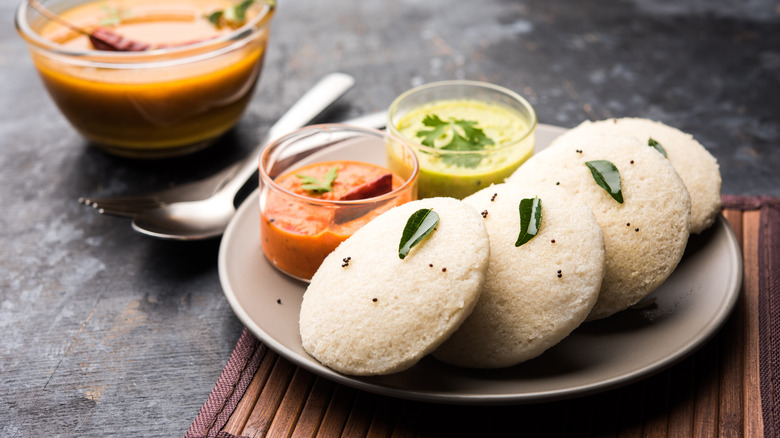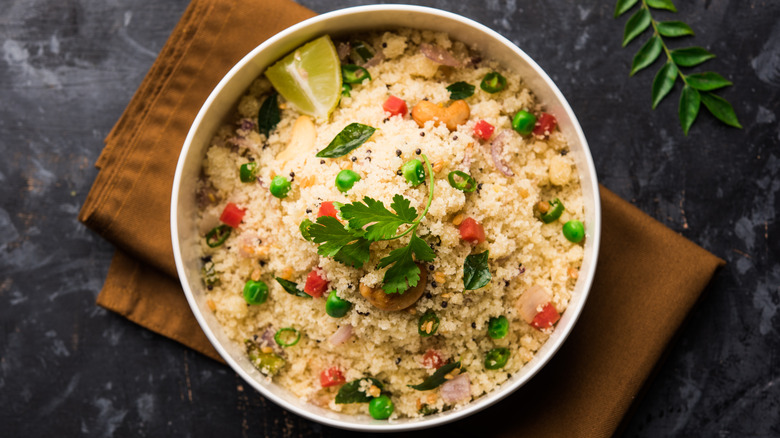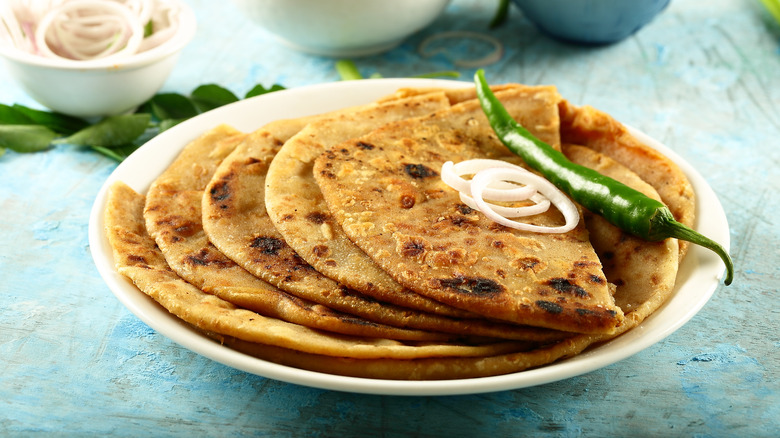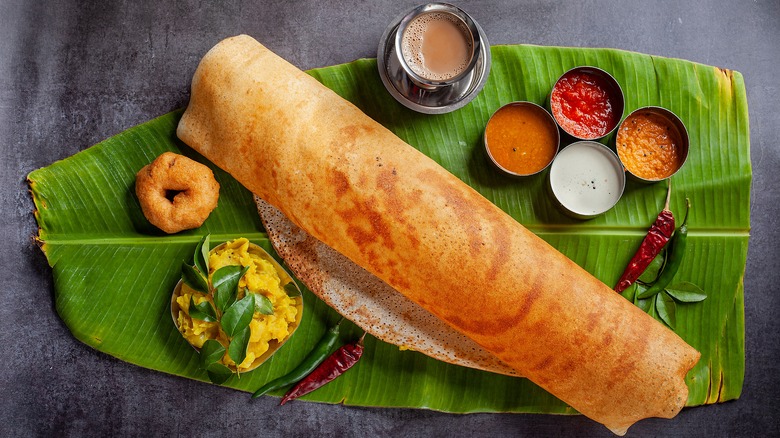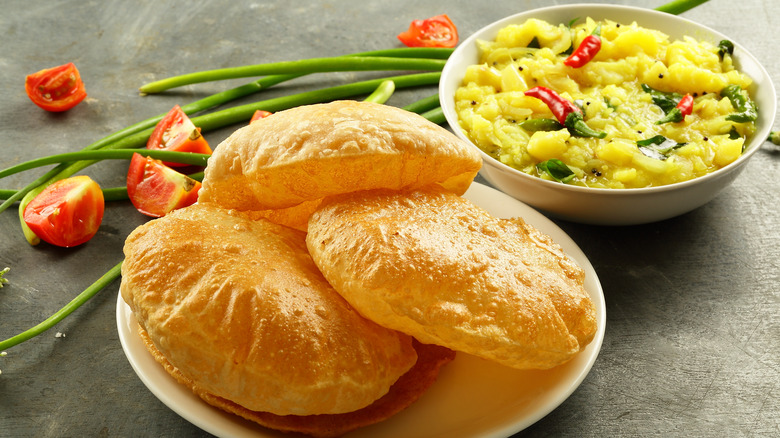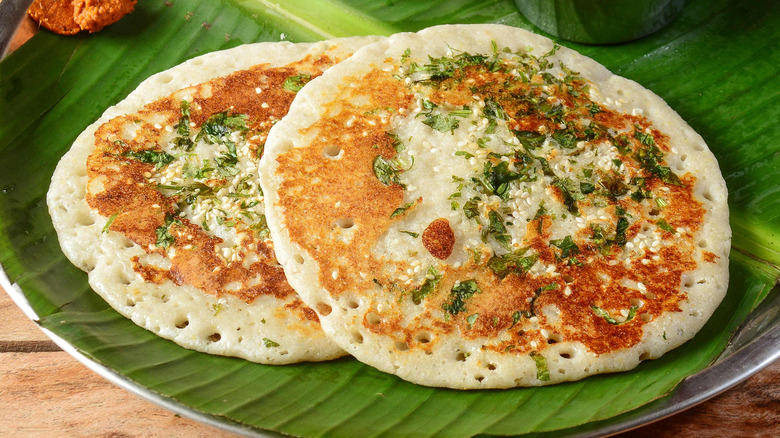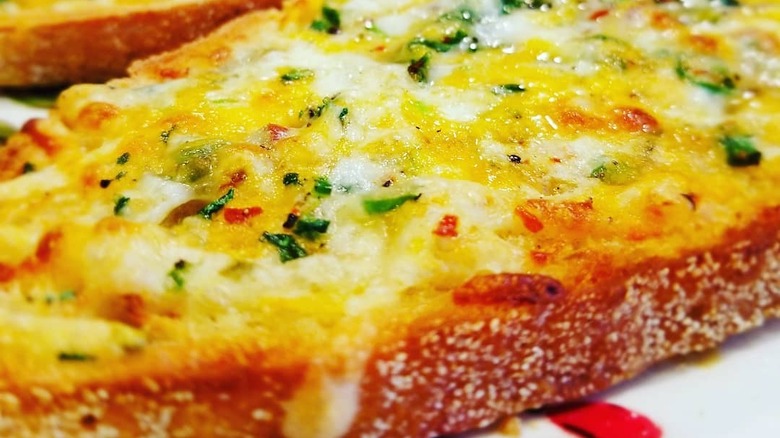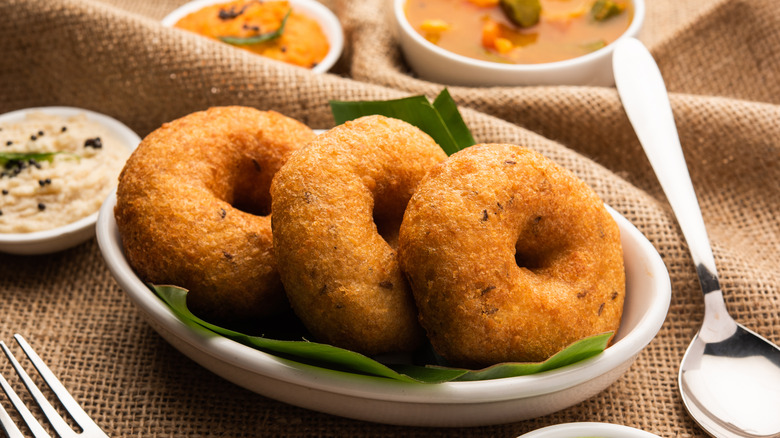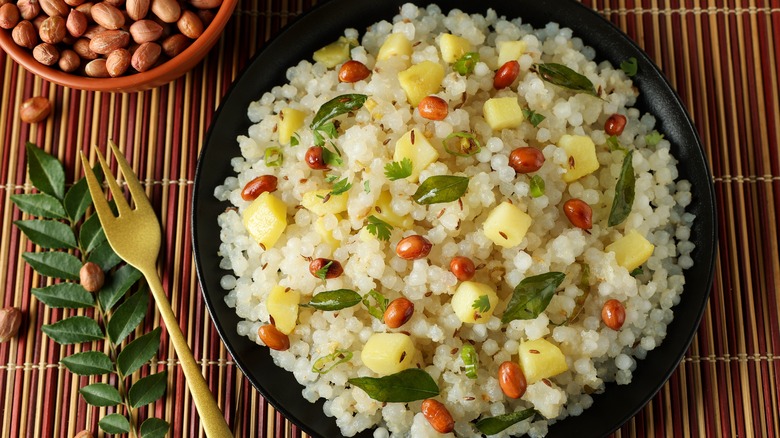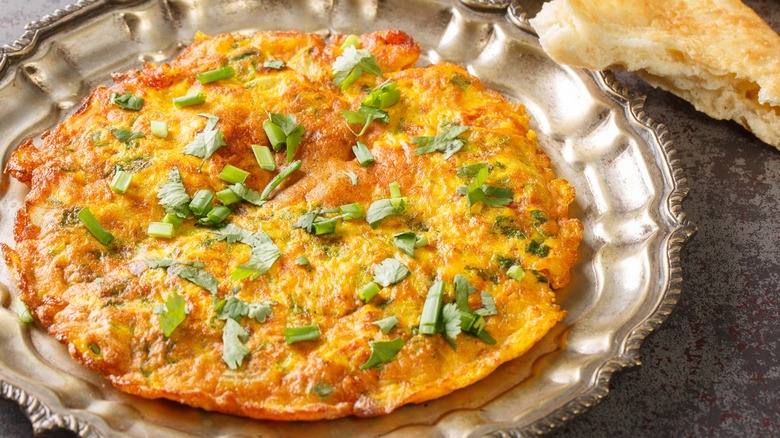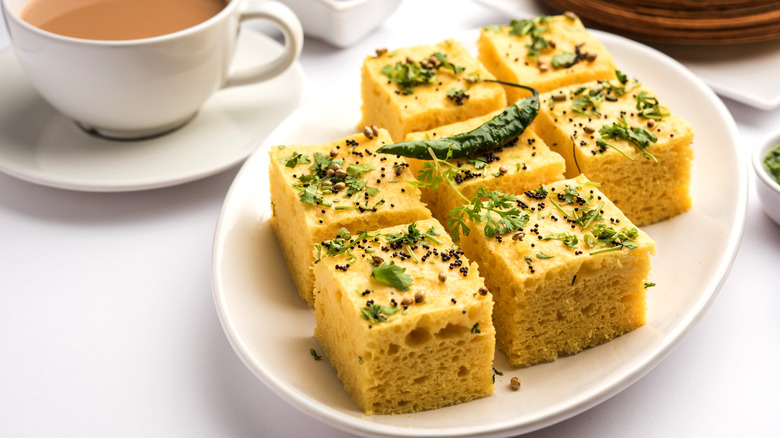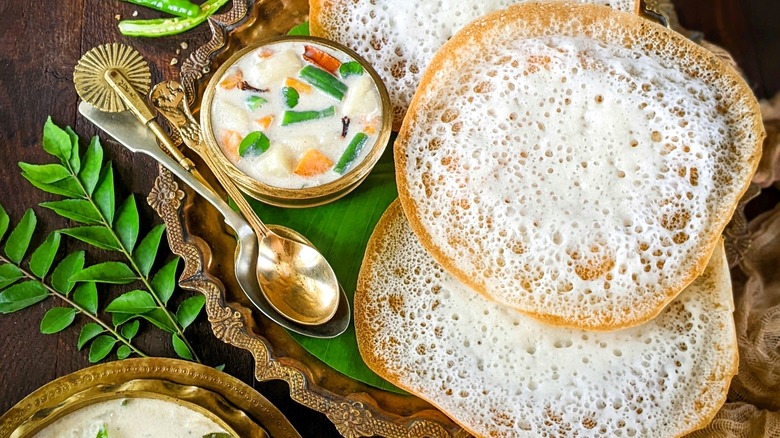15 Indian Breakfasts You Need To Try At Least Once
Have you ever woken up in the morning and pondered what to eat for breakfast? Often touted as the most important meal of the day, each culture has its traditional breakfast foods. While some people reach for toast or cereal, in comparison, Indian breakfast dishes are vibrant, varied, and vast.
Surprisingly, the concept of breakfast is relatively new in India. Talking to the New Indian Express, businessman and CEO Amarnath Halember said it was unusual to eat breakfast in India until the 14th century. He continues by explaining that this was due to the general population chiefly working on farms. As time passed and contractual employment picked up speed, more people had time for breakfast. This change resulted in the creation of new recipes, and soon breakfast became commonplace in India.
Since the advent of breakfast foods, India has stuck to its traditional fare — or at least, mostly. Commercialized breakfasts have caught on, although not in the way you may expect. According to The Print, American food manufacturing brand Kellogg's attempted to break into the market with cereal. Indians were reluctant to bite, and Kellogg's adapted to the Indian market by offering ready-to-eat upma. Nonetheless, most people prefer to cook breakfast at home or grab a street food snack — no wonder, considering the delights on offer. Now, let's dig in and explore breakfasts eaten in India.
Kanda poha
We would forgive you for thinking that kanda poha is a fried rice dish — and you would be half right. This unique recipe originating from the Western Indian state of Maharashtra is made with flattened rice, also referred to as poha. According to Tarla Dalal, flattened rice is made by parboiling rice paddy and then rolling them between two plates to flatten them. Although flattened rice has many uses in desserts, snacks, and even dosa, it is most ubiquitous with kanda poha. Unlike rice, flattened rice takes less than five minutes to cook: Soak the flattened rice in hot water for one minute, then drain and mix with other ingredients.
This recipe is spicy, sweet, and sour. Black mustard seeds bloomed in oil provide a nutty pungency, fresh curry leaves bring a bitter sweetness, and green chilis carry spiciness. Caramelized onions and whole peanuts are vital to the dish; kanda, the namesake, translates to onion in Marathi, while peanuts supply crunch. A garnish of coconut, fresh cilantro, and lemon wedges finishes the affair. You'll typically find this breakfast served with piping hot chaha — Indian tea. Meanwhile, in the neighboring state of Madhya Pradesh, Indore is famous for its specialty of poha served alongside sweet jalebi.
Besan cheela
Long before Just Egg hit our shelves, Indians have been making vegan omelets from chickpeas or lentils. Cheela (sometimes also called pudla) is a North Indian breakfast staple packed full of beneficial nutrients. This dish takes no more time to prepare than a traditional omelet yet has the added benefits of being incredibly versatile, naturally gluten-free, and plant-based.
Chickpea flour, known in Hindi as besan, is the base of the most common iteration of the dish, besan cheela. Per Healthline, just 1 cup of chickpea flour contains 20 grams of protein, plenty of fiber, and the entire daily requirement of folate. It has a pleasantly earthy and nutty flavor which pairs beautifully with the rich spice of Indian cuisine. Treat the chickpea flour as you would egg. Whisk it in a bowl with water to adjust the consistency, seasonings of your choice, and chopped vegetables for extra nutrition. Diced onions, bell peppers, spinach, and beetroot are commonly incorporated, although optional. Once whisked, the batter is poured onto a hot griddle and cooked into thin crêpes. Besan cheela can be folded and stuffed with paneer (or tofu) or served with a combination of green chutney and ketchup.
Anda bhurji
Your scrambled eggs are about to get an upgrade. It may be hard to imagine how fluffy, creamy scrambled eggs with buttered toast could get any better, but the answer is simple: Anda bhurji, Indian scrambled eggs that are full of flavor. Anda, meaning egg in Hindi, and bhurji, meaning "scrambled," (via Collins Dictionary), may directly translate to scrambled eggs, but it's so much more. Instead of salt and pepper, season the bhurji with juicy tomatoes, onions, garlic, ginger, and an array of spices, from cumin seeds to turmeric powder. The result is fluffy, buttery, spicy, fresh, and vibrant eggs just waiting for you to mop them up with Mumbai-style pav, a pillowy milk bun.
Other cultures share similar dishes, according to Scroll.in. Anda bhurji is named khagina in Pakistan, Punjab, and Afghanistan, which likely derives from a Persian dish of the same name. The food is closer to another Persian recipe named akoori, but we suspect everyone would agree anda bhurji is delicious, no matter by what name.
Idli sambar
Known as a staple of South Indian cuisine, idli is a fermented rice cake. It may sound strange to the uninitiated, but it's the best way to describe the light, fluffy, savory, and somewhat sour texture and flavor. Idli batter consists of soaked rice, white lentils, and fenugreek seeds. Next, it's ground to a smooth paste and fermented overnight, which gives the idli their distinctive sour taste. The batter is poured into a special pan and steamed for a few minutes. What comes out of the idli steamer is unrecognizable: spongy, delicate, and aromatic little discs.
Fermented rice dishes have a long history in India, particularly in the South. University College London states there is evidence of rice cultivation as early as 6,500 BC, while a paper published in the Journal of Ethnic Foods dates the practice of fermenting foods to 7,000 BC. It's unknown whether idli originated from India or traveled from then-Hindu-ruled Indonesia, as speculated by KT Achaya, (via Indian Express). What is certain, though, is that idlis have a long and beloved history for a good reason: They're delicious. You're most likely to find them stacked high and served alongside a trio of colorful chutneys or steaming hot sambar (spicy lentil soup with vegetables).
Upma
Upma holds the dubious award for being the most divisive Indian breakfast, per NDTV. While many still recall soggy, tasteless porridge, let us assure you that upma is far from mushy or bland. Others fondly recollect eating upma on weekday mornings with the whole family. But what is it? Traditionally made with semolina or vermicelli noodles called sevai, the modern age has spawned countless variations made with sorghum, quinoa, and couscous. The ingredient of choice is roasted, boiled, then tempered with ghee, dried lentils, curry leaves, spices, and cashews. If cooked properly, it's a revelation: Tender and fluffy grains coated with the rich butteriness of ghee, peppered with aromatic spices, and finished with fresh herbs.
The Hindu notes that upma has made a comeback, even for the naysayers. Now served in South Indian weddings, discerning guests dig into the breakfast with intense fervor, enjoying every mouthful. The source suggests topping upma with chivda — a spicy snack mix — provides textural diversity, while serving a spoonful of chutney on the side adds interest, and finely chopped vegetables cooked into the upma are visually appealing.
Aloo paratha
Bread is a staple that makes an appearance on breakfast tables worldwide thanks to its universal appeal and versatility. Indians, though, do bread better than most; there's a type of bread for every occasion, and breakfast is no different. Perhaps most prevalent is paratha, an unleavened and layered flatbread. One common iteration has a spiced filling in between two layers of dough, which is then shallow fried on a tawa until golden and crispy. In this case, you'll find mashed potatoes mixed with onions and fiery spices encased in a crispy dough and topped with butter. Serve it with sweet yogurt and spicy Indian pickles on the side — you couldn't ask for more.
This breakfast is in demand all over India, although it likely originates in the North-Western state of Punjab. According to a paper published in the International Journal of Applied Research, parathas feature in the book "Panjāb under the Sultāns 1000-1526 AD." The author claims that parathas were popular with the Punjabi nobility of the era. So next time you eat paratha, sit back and feel like royalty!
Masala dosa
Visit any South Indian restaurant, and you'll find at least two varieties of dosa on the menu. Likewise, any South Indian home will offer dosa on the breakfast table at least once a week. Masala dosa is the most prominent of all, showcasing soft, spiced potatoes all wrapped up in a crisp, tangy dosa. Like idli, dosa requires a batter from fermented rice, lentils, and fenugreek. The difference lies in the cooking method; instead of being steamed, it's spread in circular motions over a large tawa until a large crêpe forms. The fermentation process makes dosa a healthy option, too with large health benefits including improved digestion, immunity, and strengthening GIT, according to the Hindustan Times.
Although you can eat masala dosa without any sides, it's incomplete without the characteristic trio of chutneys and sambar. Tear off a small piece of dosa with your right hand, and scoop up a little coconut chutney or sambar. The sweet, tangy, and spicy flavors are addictive.
Puri bhaji
All across India, from the plains of the Himalayas of the North to the rainforests of the South, you'll find street vendors selling hot, puffy, and crisp puri stacked high and served with a small steel plate of batata bhaji (dry potato curry). Hearty, filling, and moreish, it's a breakfast that sustains millions of workers daily. Stalls typically sell three types of puri: sada (plain), masala (stuffed), and palak (spinach). With such variety, it's impossible to grow tired of puri bhaji.
At home, this breakfast is usually reserved for weekends since puris are a deep-fried treat. Batata bhaji with puri is also commonly eaten at Hindu festivals like Ganesh Chaturthi and Nag Panchami, especially in Maharashtra. Passionate devotees will abstain from using onion and garlic in the recipe, and traditions declare that using a knife to cut vegetables on this day is forbidden, (via The Times of India). Puri bhaji is then given as Prasad or Naivedhya, an offering to the Gods.
Uttapam
If dosa can be compared to a crêpe, uttapam is an American pancake: fluffy, spongy, soft, and pillowy. Unlike pancakes, uttapam is plant-based, as it's made with the classic fermented lentil-rice batter prevalent in South Indian cuisine. Although some people find fermented food off-putting, do stick with us. In addition to a distinctive tart flavor, fermented food is good for you, as the natural probiotics created to aid digestion help keep your gut healthy.
Plain uttapam is only cooked on one side, resulting in a golden, crispy bottom and a light, bubbly top. However, some cooks like to sprinkle finely chopped fresh vegetables on top while the uttapam is still cooking. The flavor of the fresh vegetables helps to balance the natural sourness of the batter; most popularly, onions and carrots add a hint of sweetness, while fresh cilantro boasts citrusy notes. Those who like it spicy can scatter gunpowder on the uttapam. No, not the explosive kind — this is a South Indian spice mix made from chili peppers, named because it has such explosive heat. Drizzle oil on top, flip the uttapam and cook until the vegetables are slightly charred.
Chilli cheese toast
Amul, India's largest dairy brand, has turned over an annual revenue of $560 million, (via The Economic Times). According to BBC, the group formed in 1946, one year before India's independence, as a cooperative of farmers. In the modern age, Amul is known for making butter, milk, and cheese, amongst other dairy products. But why are we telling you about Amul? Indian street food is full of cheese — Amul cheese, to be specific. Yet, one cheesy street food was there before all others. It's India's answer to American grilled cheese and Welsh rarebit: Chilli cheese toast. Crispy, toasted bread topped with oozing cheese, umami tomato, fresh cilantro, and plenty of chilli... that's chili cheese toast.
The Hindustan Times writes that the likely inventor of chilli cheese toast was the ex-executive chef of the Taj Hotel in Mumbai, Satish Arora. From that day in 1975, it seemed to spread like wildfire: Soon, every street food stall, Irani cafe, and hotel in Mumbai sold the cheesy, spicy breakfast. And now, back to Amul. In the cookbook "Dishoom: From Bombay with Love," British-Indian restaurateur Shamil Thakrar notes that Amul cheese will make the whole thing taste more authentic, but in place of that, mature cheddar will also do.
Medu vada
The West hasn't quite yet caught onto savory donuts (maple bacon donuts are still pretty sweet), but in Karnataka, the birthplace of Udupi cuisine, medu vada has been eaten for centuries. "The Story of Our Food," published by Indian scientist K.T. Achaya, references a book written by King Someshvara III of the Western Chalukya Empire in the 12th century. The book, "Manasollasa," details cultural information about ancient India and makes several references to food — including medu vada, referred to as vataka in those times.
A batter made from white urad lentils ground into a smooth consistency with a stone grinder is the basis for medu vada. Plant-based and gluten-free, it features divine spices like earthy cumin seeds, piquant black pepper, curry leaves, green chilis, and ginger peppered throughout the batter. The batter is wet, so the process of forming the donuts is done by hand and requires some practice. Once shaped, they are immediately dropped into hot oil and fried until fluffy. The flavor is mildly spicy and improves even further when dunked into hot sambar.
Sabudana khichdi
Let's begin by explaining what sabudana is. Per Tarla Dalal, sabudana is made by extracting milk from tapioca root, processing it, and making little "pearls" from the liquid. Now a staple in the Indian diet from Maharashtrian sabudana khichdi to South Indian coconut and cardamon tapioca pudding, tapioca was first popularized in the late 1800s, according to Condé Nast Traveller. Filling and cheap, it became the perfect solution to a famine-struck Kerala and would go on to save the day again when a rice shortage struck India in the fallout of World War II.
Sabudana has only gained traction since then, especially as a fasting food. Sabudana khichdi is a particularly adored breakfast during Navratri, a nine-day Hindu festival that traditionally involves upvas (fast). Commonly made without onions and garlic, it's also a sattvic food, described by WebMD as an Ayurvedic diet believed to help increase energy and mental clarity. Sabudana khichdi has minimal spices: Cumin seeds, curry leaves, green chili, and rock salt are standard, while coconut and sugar are optional. Soaked sabudana is mixed with these spices, then sautéed with boiled potatoes, whole peanuts, fresh cilantro, and lemon juice. Often fresh yogurt is served alongside the comforting meal.
Masala omelet
Take a simple omelet and add plenty of sweet onion, zesty cilantro, punchy chili, fresh tomatoes, and a myriad of spices: It transforms into something revolutionary. Many people are scared to add spice to eggs, afraid that the intense flavors will override the delicate taste of eggs. But in India, all Western rules are thrown out of the window in favor of culinary exploration and adventure. Masala omelet retains the natural creaminess of eggs, buttery and crisp edges, and gentle spices that add a little warmth. The way eggs sizzle when added to hot oil and the earthy aroma of cumin wafting through the air lets you know this breakfast will be delicious.
Although you can eat a masala omelet without any sides, it shines when paired with bread. Fluffy white sandwich bread gently warmed and spread with copious amounts of butter makes the perfect vessel for the piping hot omelet. Alternatively, a crispy layered paratha or tortilla wrap pressed onto the not-quite-set top of an omelet provides a quick, easy, and tasty meal.
Dhokla
Soft, spongy, and airy, dhokla is a savory sponge cake native to the Western-Indian state of Gujarat. The traditional method involves fermented rice, yogurt, and lentil batter, (via Ethnic Fermented Foods and Beverages of India: Science, History, and Culture), while the modern "instant" dhokla recipe includes chickpea flour and a raising agent like fruit salts, citric acid, or baking soda. Water seeped with ginger, garlic, and green chili adjusts the consistency, then the batter is poured into a cake mold and steamed until light and fluffy.
The final step in making dhokla may surprise you. Black mustard seeds, curry leaves, green chili, sesame seeds, asafoetida, salt, and sugar are fried in oil before you add water. The mixture is left to simmer for a few seconds, then poured over the hot dhokla. It infuses the sponge with bold spicy, sweet, and tangy flavor notes, and the finishing touch is to garnish with fresh cilantro and grated coconut.
Appam
Popular in the South Indian states of Tamil Nadu and Kerela, appam are thin, lacey, and crispy pancake-esque breakfast items. They're uniquely made from a fermented rice batter infused with coconut milk, imparting a sweet and nutty flavor. You may find curry served on the side of the appam or an egg cooked in the middle of the pancake — ideal for breakfast.
Some food historians attribute the Indian Jewish community, the first of whom arrived around 2,000 years ago, (via BBC), with the invention of the tasty appam. Although the Jewish population has since dwindled in India, a variation called pesaha appam is traditionally prepared to celebrate Passover by the Syrian Christians and Cochin Jews of India, according to the site Air Asia. The same source asserts that others point to an ancient Tamil poem from the 2nd century, "Perumpanuru," as an indication that the appam originated within South India.
